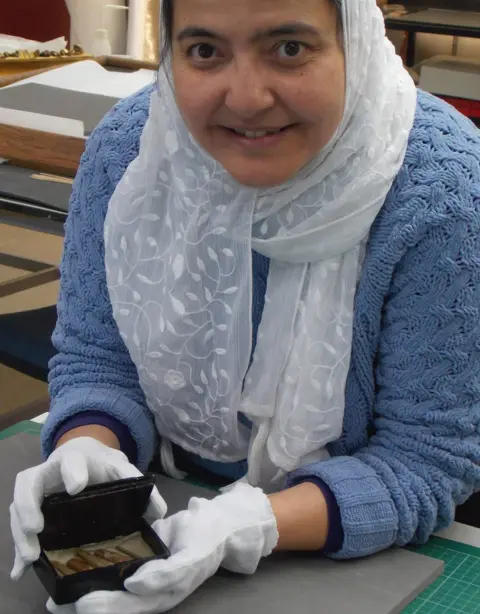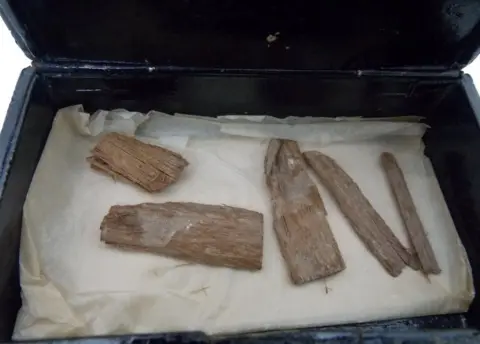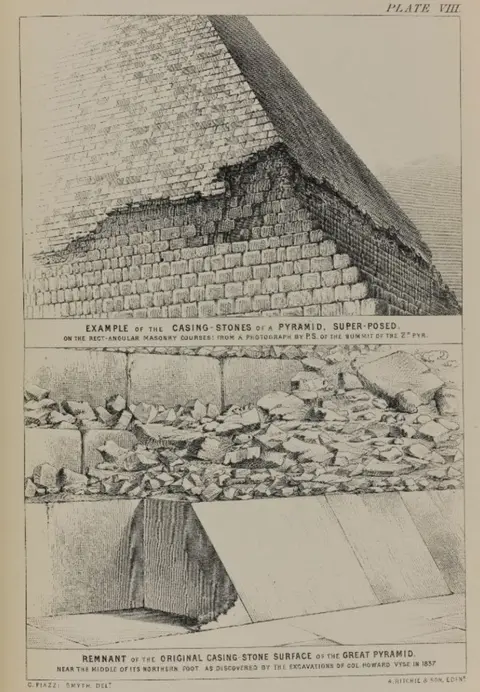Great Pyramid: Lost Egyptian artefact found in Aberdeen cigar box
A long-lost Egyptian artefact has been found in a cigar box in Aberdeen - and it is hoped it could shed new light on the Great Pyramid.
The chance discovery was made by a member of staff at the University of Aberdeen during a collection review.
The small fragment of 5,000-year-old wood - which is now in several pieces - is said to be "hugely significant".
The engineer Waynman Dixon originally discovered it among items inside the pyramid's Queens Chamber in 1872.
The piece of cedar - which it is believed may have been used during the pyramid's construction - was donated to the university in 1946 but then could not be located.
Curatorial assistant Abeer Eladany found it while conducting a review of items housed in the university's Asia collection.
 University of Aberdeen
University of Aberdeen
Abeer, who is originally from Egypt and spent 10 years working in the Egyptian Museum in Cairo, cross-referenced it with other records.
'Hidden in plain sight'
"Once I looked into the numbers in our Egypt records I instantly knew what it was, and that it had effectively been hidden in plain sight in the wrong collection," she said.
"I'm an archaeologist and have worked on digs in Egypt but I never imagined it would be here in north-east Scotland that I'd find something so important to the heritage of my own country.
"It may be just a small fragment of wood, which is now in several pieces, but it is hugely significant given that it is one of only three items ever to be recovered from inside the Great Pyramid."
 University of Aberdeen
University of AberdeenTwo other items found by Waynman Dixon - a ball and hook - are now housed in the British Museum, but the wood was missing.
"The university's collections are vast - running to hundreds of thousands of items - so looking for it has been like finding a needle in a haystack," Abeer added.
"I couldn't believe it when I realised what was inside this innocuous-looking cigar tin."
 National Museums Scotland
National Museums Scotland
Covid restrictions delayed the dating of the rediscovered cedar fragment.
Results have recently been returned and show that the wood can be dated to somewhere in the period 3341-3094 BC.
'Quite a revelation'
This is said to support the theory that, whatever their use, the so-called Dixon Relics were original to the construction of the Great Pyramid and not later artefacts left behind by those exploring the chambers. But the dating is also surprising as historical records have dated the pyramid itself to a period about 500 years later.
Neil Curtis, head of museums and special collections at the University of Aberdeen, said: "Finding the missing Dixon Relic was a surprise but the carbon dating has also been quite a revelation. It is even older than we had imagined.
"This may be because the date relates to the age of the wood, maybe from the centre of a long-lived tree. Alternatively, it could be because of the rarity of trees in ancient Egypt, which meant that wood was scarce, treasured and recycled or cared for over many years."
He added: "It will now be for scholars to debate its use and whether it was deliberately deposited, as happened later during the New Kingdom, when pharaohs tried to emphasise continuity with the past by having antiquities buried with them.
"This discovery will certainly reignite interest in the Dixon Relics and how they can shed light on the Great Pyramid."
You might be interested in:
